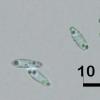
28-10-2025 19:33
 Nicolas Suberbielle
Nicolas Suberbielle
Bonjour à tous,Je voudrais votre avis sur cette r

31-10-2025 09:19
 Lothar Krieglsteiner
Lothar Krieglsteiner
Can somebody provide me with a file of:Rogerson CT

09-08-2025 13:13
 Maria Plekkenpol
Maria Plekkenpol
Hello,Yesterday I found these on burnt soil. Apoth

25-11-2016 13:54
 Stephen Martin Mifsud
Stephen Martin Mifsud
Hi, I found numerous seeds of Washingtonia robusta

28-10-2025 22:22
 Bernard Declercq
Bernard Declercq
Hello.I'm searching for the following paper:Punith

28-10-2025 15:37
Carl FarmerI'd be grateful for any suggestions for this strik
Discomycetes
Claude Kaufholtz-Couture,
26-10-2014 16:45
Mon étude préliminaire m'indique qu'il ne s'agit pas de Bisporella citrina.
Que dois-je rechercher exactement pour m'aider à trouver le nom de cette espèce ?
Sporée blanchâtre
Spores cylindriques, fusiformes à subbacilliformes, lisses, à paroi mince, n'ayant aucun septum, l'appendice hilaire non visible, à contenu guttulées à biguttulées, verdâtres dans le NaCl isotonique 0,9 %, inactives dans le Melzer, cyanophiles
7,4 [8,8; 9,4] 10,7 x 2,7 [3,1; 3,2] 3,5 µm
Q = 2,3 [2,8; 3] 3,5; N = 30; C = 95%
Me = 9,1 x 3,1 µm; Qe = 2,9
Je vous remercie !
Claude
Hans-Otto Baral,
26-10-2014 18:01

Re : Discomycetes
Bonjour Claude
Maybe you expected to see septate spores? The septum is formed in Bisporella citrina only on overmature spores, so don't worry. If the excipulum is gelatinized I am quite sure it is this species. You can also look at the ascus apex in IKI, but you need dead asci for that. The apical ring is a bit like a T, while for instance in Bisporella subpallida it is only reactive in the lower part of the wall thickeningl like two short thin lines, Also the contents of the paraphyses are worth to look at.
The difference in apicla ring and genetic data led me to say Calycina citrina for the present fungus, so I restrict Bisporella to B. subpallida and B. pallescens.
Zotto
Maybe you expected to see septate spores? The septum is formed in Bisporella citrina only on overmature spores, so don't worry. If the excipulum is gelatinized I am quite sure it is this species. You can also look at the ascus apex in IKI, but you need dead asci for that. The apical ring is a bit like a T, while for instance in Bisporella subpallida it is only reactive in the lower part of the wall thickeningl like two short thin lines, Also the contents of the paraphyses are worth to look at.
The difference in apicla ring and genetic data led me to say Calycina citrina for the present fungus, so I restrict Bisporella to B. subpallida and B. pallescens.
Zotto




